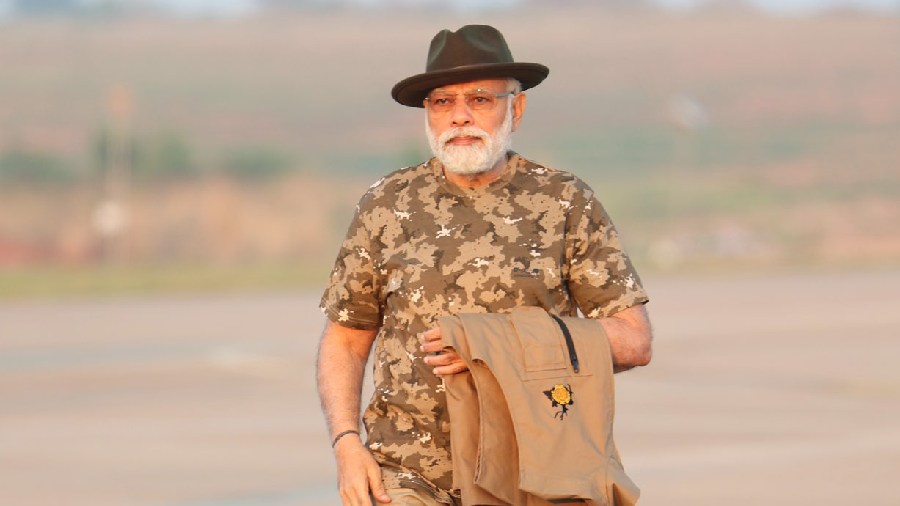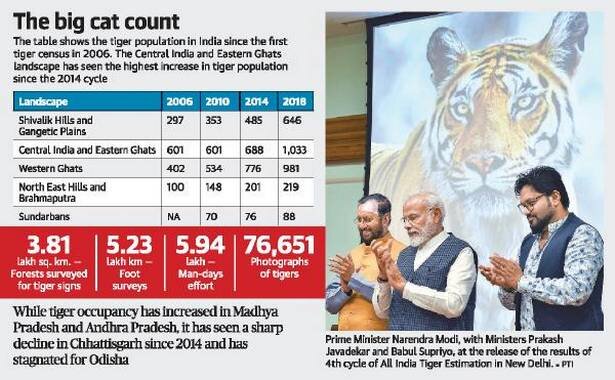Table of Contents
As of 2022, India has 3,167 wild tigers, according to Prime Minister Narendra Modi’s 5th Tiger Census. In July 2019, the 2018 Tiger Census reported 2,967 Indian tigers. The country’s animal population has grown by 200 or 6.7 percent in four years. The nation had 1,411 tigers in 2006, 1,706 in 2010, and 2,226 in 2014.
Celebration Of Tiger Census
To celebrate Project Tiger’s 50th anniversary, PM Modi launched the Tiger Census in Mysuru, Karnataka. The three-day meeting will safeguard and conserve tigers, lions, leopards, snow leopards, pumas, jaguars, and cheetahs.
At the opening session of the 50th anniversary of “Project Tiger,” PM Modi published “Amrit Kaal Ka Tiger Vision,” a booklet outlining his 25-year tiger conservation plan. The Indian prime minister added that wildlife conservation was a global concern and that IBCA was India’s effort to conserve big cats.

Project Tiger is 50. Project Tiger was a global triumph for India. India saved the tiger and gave it a fantastic environment. At 75 years of independence, India has over 75% of the world’s tiger population and 75,000 square kilometres of tiger reserves. Everyone contributed to this.
Project Tiger was launched at Jim Corbett National Park, Uttarakhand, on April 1, 1973. Project Tiger now covers 54 states in 18 tiger ranges.
Tiger reserves are core/buffer. The buffer or periphery regions are mixed forest and non-forest land maintained as a multiple use area, whereas the core parts are national parks or sanctuaries.
It is a Ministry of Environment, Forests, and Climate Change Centrally Sponsored Program that helps tiger States conserve tigers in designated tiger reserves.
The Wildlife (Protection) Act, 1972 gives the Ministry’s statutory National Tiger Conservation Authority (NTCA) supervisory/coordination powers. Following Tiger Task Force recommendations, the NTCA was founded in 2005. With the 2006 revision of Wildlife (Protection) Act, 1972, it became a statutory body..

Buffer areas provide additional habitat for spreading tigers and allow human activities. The Gram Sabha and an Expert Committee decide the buffer/peripheral area limits using scientific and objective criteria.
The GTRP empowers Tiger Range Countries (TRCs) to manage domestic and transboundary risks and promote financial sustainability by integrating conservation objectives into development.
Petersburg Declaration on doubling the tiger population was signed in 2010 by all 13 Asian tiger range countries—Bangladesh, Bhutan, Cambodia, China, India, Indonesia, Lao PDR, Malaysia, Myanmar, Nepal, Russia, Thailand, and Vietnam—and partner organisations of the Global Tiger Initiative to create the first coordinated, rangewide, and international effort to save the world’s tigers. The Petersburg Declaration on Tiger Conservation from the St. Petersburg Tiger Summit called on the governments of these 13 tiger home range countries to double the global tiger population by 2022 under GTRP.

India contributes 8% of world wildlife diversity with 2.4 percent of land area. India has the greatest tiger range. The Prime Minister also noted that lions, leopards, elephants, and single-horned rhinos had risen, with India having the greatest population of Asiatic elephants and rhinos and being the only country with Asiatic lions.
Madhya Pradesh caverns include 10,000-year-old tiger murals. Several Indian tribal cultures revere tigers.
Asiatic lions have climbed from 525 in 2015 to 675 in 2020, while leopards have increased 60% in four years due to conservation initiatives. The National Mission for Clean Ganga also revived endangered aquatic species. Conservation and preservation culture are to be credited for this.
Conservation requires an emotional and economic relationship between human societies and animals. “Ecology and economy” do not clash.
A multinational partnership is crucial since wildlife conservation is, and will remain, a global issue. The worldwide conference will share best practices and financial and technical resources. Research, training, and capacity will be prioritised.













